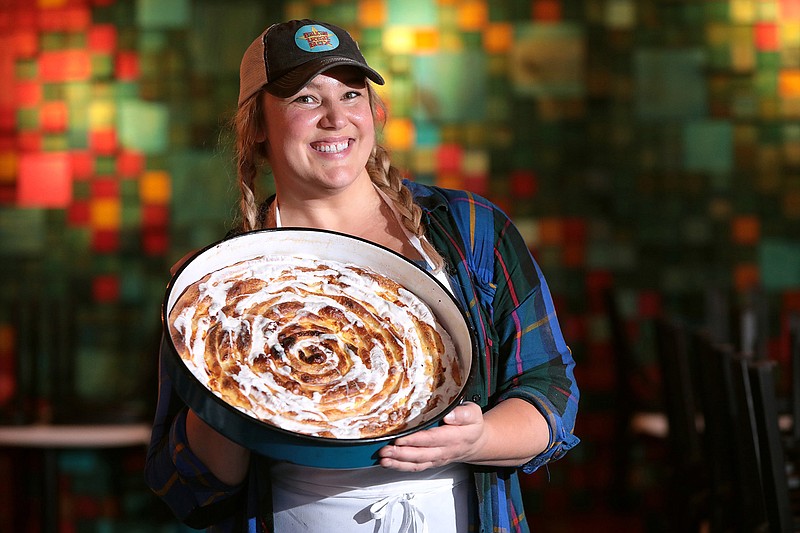ST. LOUIS - For many Balkan women, making the dish is like a reflex. Its technique gets passed down from generation to generation.
For my baba, gibanica is a cheese and phyllo-dough creation she lovingly feeds (overfeeds?) her family. For Loryn Nalic of Balkan Treat Box, the same dish is called sirnica, one of the first Balkan recipes she learned. For me, it's the cheese-filled wonder I'd always hoped to learn how to make, partly as a way of carrying on my family's heritage, partly because it's just so delicious.
Photo Gallery
Cajuns Deck Party
Cajuns Big Swinging Deck Parties are officially awesome and the place fills up quickly during happy hour and stays lively til latenight. Tragikly White performed downstairs on the main stage.
My dad's family came to the U.S. when he was 8. He later married my Italian mother. Unfortunately, not many of my dad's Serbian traditions were handed down to my two brothers and me. We don't speak Serbian (except for curse words - thanks, Uncle Dennis), we don't go to Serbian church, and we definitely don't roast a whole pig on a spit in our front yard.
But what we do have is gibanica.
Gibanica is to Serbs what pizza is for Americans. It's a simple dish consisting mostly of eggs, cheese and oil sandwiched between layers of phyllo dough. People eat it for breakfast, lunch, dinner, a snack, to fix hangovers.
Every time my family goes to visit my Serbian grandmother, or Baba, we joke how the whole neighborhood smells like Serbian food. No matter how much my father stresses that "we're just stopping by," Baba will make enough food to feed a small village. There's never enough gibanica, though.
It's the first food my family eats at gatherings, and it's the first food to disappear.
Everything about it evokes nostalgia in me: the gooey, cheesy texture; the crunch of the outside layers. Besides the calories, you can't go wrong with gibanica.
There's no one way to make gibanica, the same way there isn't a single way to make a hamburger. Almost every Balkan or Slavic country has a version of the dish or something similar to it. Many countries make Burek, a phyllo dough-based pie stuffed with beef and sometimes cheese. Greeks have their spinach pie, spanakopita.
The word gibanica itself is a combination of two separate languages: the Croatian verb "gibati" and a Serbian verb meaning "to fold, sway, rock." Altogether, it means "folded pie."
When I asked Balkan Treat Box's owner and chef Loryn Nalic about the dish, she knew it as "sirnica."
"It's one of my kids' favorite dishes," Nalic says. "It was the first thing I learned to make when Edo and I were together because he loves it so much."
Loryn and her husband, Edo, turned their food truck into a brick-and-mortar restaurant last year to national acclaim. They invited me into their restaurant on a Monday afternoon, when the day was dim but the wood fire in their oven burned bright.
Everyone makes gibanica and its variants differently. Nalic makes hers with fresh dough and cheese she makes herself. I use store-bought phyllo dough and cottage cheese. Loryn lines dollops of cheese and rolls the filling with the dough into one big coil. I sprinkle oil and cheese on layer after layer of dough.
"It's a pretty universally loved dish," Nalic says.
It's a very simple dish once you get the technique down. There's a certain way to handle the dough, whether you're making it yourself or buying it from a store.
Nalic says the first time she watched someone make phyllo dough from scratch, it brought tears to her eyes. "It is an art form," she says.
When I saw Nalic and her mother-in-law, Zeta, make and stretch the phyllo dough, I was near tears, too. The way she expertly expanded the dough on a table brought to my mind the countless generations of Balkan women teaching their daughters how to make it and how that knowledge spread to my Baba through a great-grandmother I never met, and now me.
Each time I ask Baba for a written recipe (there have been many times), she'll recite the ingredients and say, "Just make it." I asked her to teach me how to make it again for this article, with pen and paper in hand.
Now, I'm the one making the neighborhood smell like Serbian food.
Gibanica
Yield: 10 servings
2 pounds phyllo dough, preferably the thickest, "country style" type
7 eggs
1 1/2 pounds cottage cheese
1 teaspoon salt
1 teaspoon baking powder
1/2 pound farmers' cheese or feta, crumbled
3 tablespoons soda water
2/3 cup corn oil, divided
Notes: Use the deepest metal baking pan you have, preferably at least 2 1/2 inches.
1. Thaw phyllo dough according to package instructions. Grease bottom of an extra-large baking pan, preferably 11-by-16-inches. Preheat oven to 425 degrees.
2. Whisk eggs in a large bowl, then stir in the cottage cheese, salt, baking powder and farmers' cheese. Stir in the soda water.
3. Cover the bottom of the pan with a single layer of phyllo dough, making sure some of the pieces hang over the sides. Evenly sprinkle 1 tablespoon oil over the dough.
4. Take a piece of phyllo dough and wrinkle it into the dish with as many bumps as possible so it doesn't lie flat. Depending on the size of your pan, use 2 to 3 pieces of dough for each layer. Evenly sprinkle 1 tablespoon oil on the dough, including the sides and corners. Do not allow the oil to pool.
5. Sprinkle 1/2 to 3/4 cup egg-and-cheese mixture on the dough, including the sides, enough to make sure the edges and crevices are covered. Do not allow the mixture to pool.
6. Repeat laying down 2 to 3 pieces of wrinkled dough and sprinkling them with oil and the egg-and-cheese mixture until you have 1 layer of dough left. Cover the top of the dish with that last remaining layer, folding in any excess on the sides. Cover the top with a final layer of the egg-and-cheese mixture and oil, but do not dump any mixture leftovers on top.
7. Bake 40 minutes or until the top turns golden brown and the sides separate from the pan.
Per serving: 568 calories; 30 g fat; 9 g saturated fat; 43 mg cholesterol; 21 g protein; 53 g carbohydrate; 4 g sugar; 2 g fiber; 1,139 mg sodium; 260 mg calcium
-Recipe by Monica Obradovic


